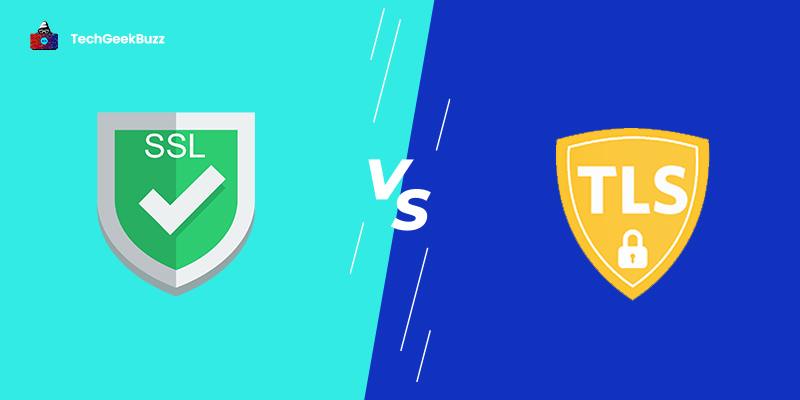SSL and TLS are cryptographic protocols gaurantee data privacy, authenticity, and integrity over a network. This post will clarify SSL versus TLS for those confused about the distinctions between the two protocols.
Security is paramount in today’s digital and technological-driven world. As we transfer bulk data over the internet, protecting it from falling into the wrong hands is essential. This is where internet security protocols come into play, namely, the security and integrity of data over the internet.
SSL and TLS are two popular Internet security protocols. They prevent hackers from accessing and tampering with data transferred between a web browser and a web server . They ensure the security of the network communication.
Besides website owners and operators, many TCP-based protocols, including email, instant messaging, FTP, and VoIP, use these internet security protocols.
While SSL stands for Secure Socket Layer , TLS is an acronym for Transport Layer Security. TLS is the successor to SSL, which is considered obsolete and insecure. Transport Layer Security is the updated version and has become a standard protocol, but it is still popularly known as SSL.
This article aims at explaining to you the differences between SSL and TLS. Before delving deeper into the differences, let us first understand them individually.
What is SSL?
An encryption-based internet security protocol, Secure Socket Layer is the first of its kind. It encrypts the data transferred between the client (web browser) and the server (web server), thus providing security against cyber threats .
The primary aim of designing the Secure Socket Layer was to authenticate and maintain the integrity and privacy of internet communication.
History
A chief scientist at Netscape Communications, Taher Elgamal, designed the first version of SSL (Version 1.0) in 1995. He is well-known as the ‘ Father of SSL ’. However, he did not publicly release the first version because of severe security issues.
Further, Version 2.0, after its immediate release, was revealed to contain various security and usability issues. Hence, it was not up to the mark.
It used the MD5 hash function with a secret prefix, leading to weak MAC construction. The generated MAC was vulnerable to length extension attacks.
Additionally, Version 2.0 was so weak that it would leave the Man-in-the-Middle (MITM) attack undetected.
These drawbacks forced the redesign of the protocol and resulted in Version 3.0. In 2014, Version 3.0 was found vulnerable to the POODLE attack . This attack affected all block ciphers in the Secure Socket Layer. In 2015, Version 3.0 was deprecated.
What is TLS?
Yet another encryption-based internet security protocol, Transport Layer Security, is the successor to the Secure Socket Layer. This cryptographic protocol provides end-to-end security for data transferred over a computer network.
With cryptography , TLS aims to provide a high level of privacy, integrity, and authenticity between communicating devices over a network.
History
Internet Engineering Task Force (IETF), an organization in charge of introducing the Internet standards, introduced Transport Layer Security (Version 1.0), an upgrade to SSL 3.0, in 1999.
Even though the changes between these two protocols were not dramatic, they were enough to prevent their compatibility.
The year 2006 witnessed the release of TLS 1.1 with a few differences. In 2008, Version 1.2 was released with significant differences. After 10 years and 30 IETF drafts, Version 1.3 was released, the most recent version.
Recently, in 2020, many websites deprecated Version 1.0 and 1.1. So, Version 1.2 and 1.3 are the players in the internet landscape.
How Do SSL and TSL Secure Data?
Initially, you must install the SSL/TLS certificate (simply called the SSL certificate) on your web server. It comprises a public and private key for web server authentication, allowing the web server to encrypt and decrypt your data.
When users visit your website, their browser will check whether it uses the SSL/TLS certificate . If yes, it will perform a handshake to verify the certificate’s validity and authenticate your web server.
Your users get a message “ Your connection is not private ” if the certificate is invalid. As a result, visitors leave your website.
In contrast, if a visitor’s browser finds that the certificate is valid, it creates an encrypted link connecting to your web server for secure data transfer.
Now, the role of the HTTP ( Hypertext Transfer Protocol ) protocol comes into play. It is an application layer protocol for data transfer between networked devices. In other words, it is a client-server protocol wherein clients send requests, and the web server responds to them.
With only HTTP, hackers or eavesdroppers can access and manipulate the data exchanged between the client and server over a network. However, with HTTPS or HTTP over SSL/TLS, the data transferred over a network is encrypted, protecting it from threat imposters.
Why Is an SSL/TLS Certificate Called an SSL Certificate?
In the above sections, we have discussed that Transport Layer Security is an improved verison of the Secure Socket Layer. Also, you have learned that public releases of the Secure Socket Layer have been deprecated due to security vulnerabilities.
With this discussion, a question may arise: Why is an SSL/TLS certificate called simply an SSL certificate?
The primary reason is the branding issue. Most certificate providers refer to it as an SSL certificate. Hence, this naming convention exists. This does not mean that it uses the Secure Socket Layer protocol.
All SSL certificates available are, in fact, SSL/TLS certificates.
Remember, there is nothing like an SSL or TLS certificate.
SSL vs TLS - Know the Differences
Let us explore some differences between these protocols below.
-
Cipher Suites
The primary difference between these two protocols is the use of cipher suites. A cipher suite is a collection of algorithms to encrypt data.
Transport Layer Security, especially Version 1.3, leverages an improved and enhanced cipher suite, such as Perfect Foward Secrecy .
-
Alert Messages
Both protocols have different approaches to handling alert messages. The primary use of alert messages is to display error conditions and warnings.
The Secure Socket Layer has unencrypted alert messages. This means anyone can read and intercept those alert messages.
In contrast, Transport Layer Security has encrypted alert messages, ensuring only the parties involved in communication can read them.
-
Handshake Process
You can ensure the secure establishment of a connection between two parties with the handshake process. Both these cryptographic protocols have different handshake processes.
The handshake process in the Secure Socket Layer is a two-step: “full handshake” and “abbreviated handshake”. The same process is one step in Transport Layer Security called “ full handshake”.
-
Record Protocol
The record protocol encapsulates the data exchanged over a network. The Secure Socket Layer uses the SSL record protocol developed by Netscape. On the flip side, Transport Layer Security leverages the TLS record protocol developed by IETF.
-
Message Authentication
It is a process of verifying the data received is the same as the data sent. It implies there should be no manipulation of data being transferred. Both protocols use different message authentication algorithms.
The Secure Socket Layer uses the MD5 algorithm, while the Transport layer Security leverages the SHA-256 algorithm. The MD5 algorithm is not secure, while the SHA-256 algorithm is.
The following table highlights the differences between SSL and TLS:
|
Secure Socket Layer |
Transport Layer Security |
|
It supports the Fortezza algorithm . |
It does not support the Fortezza algorithm. |
|
The Message Digest creates a master secret. |
A Pseudorandom creates a master secret. |
|
The Secure Socket Layer is complicated. |
Transport Layer Security is simple. |
|
It provides less security. |
It provides high security. |
|
All public releases of the Secure Socket layer have been deprecated. |
Version 1.2 and 1.3 are still used globally. |
|
Three versions: Version 1.0, 2.0, & 3.0 |
Four versions: Version 1.0, 1.1, 1.2, & 1.3 |
Is Transport Security Layer Replacing Secure Socket Layer?
Yes, the Transport Security Layer is replacing the Secure Socket Layer. As discussed above, most websites have deprecated all Secure Socket Layer public releases, as it is not entirely secure.
In addition, TLS is an improved and updated version of SSL. More importantly, TLS 1.3 is even more secure and offers performance benefits.
Remember, Google Chrome stopped supporting Secure Socket Layer 2.0 and 3.0 in 2014. Also, many services have deprecated TLS 1.0 and 1.1.
As a result, ensure the latest version of Transport Layer Security is used.
Conclusion
SSL and TLS protocols encrypt data to ensure its privacy and authenticity over the internet. The significant difference between these two is that the latter is an improved, secure, and updated version.
From the above discussion, the clear winner is Transport Layer Security. Also, when people say Secure Socket Layer, they mean Transport Layer Security, as both public versions of SSL are not supported. Again, when people say SSL certificates, they mean SSL/TSL certificates.
People are also reading:





Leave a Comment on this Post